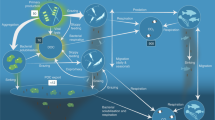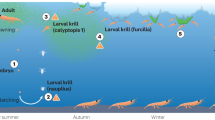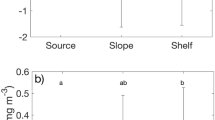Abstract
Antarctic krill (Euphausia superba) and salps (mainly Salpa thompsoni) are major grazers in the Southern Ocean1,2,3,4, and krill support commercial fisheries5. Their density distributions1,3,4,6 have been described in the period 1926–51, while recent localized studies7,8,9,10 suggest short-term changes. To examine spatial and temporal changes over larger scales, we have combined all available scientific net sampling data from 1926 to 2003. This database shows that the productive southwest Atlantic sector contains >50% of Southern Ocean krill stocks, but here their density has declined since the 1970s. Spatially, within their habitat, summer krill density correlates positively with chlorophyll concentrations. Temporally, within the southwest Atlantic, summer krill densities correlate positively with sea-ice extent the previous winter. Summer food and the extent of winter sea ice are thus key factors in the high krill densities observed in the southwest Atlantic Ocean. Krill need the summer phytoplankton blooms of this sector, where winters of extensive sea ice mean plentiful winter food from ice algae, promoting larval recruitment7,8,9,10,11 and replenishing the stock. Salps, by contrast, occupy the extensive lower-productivity regions of the Southern Ocean and tolerate warmer water than krill2,3,4,12. As krill densities decreased last century, salps appear to have increased in the southern part of their range. These changes have had profound effects within the Southern Ocean food web10,13.
This is a preview of subscription content, access via your institution
Access options
Subscribe to this journal
Receive 51 print issues and online access
$199.00 per year
only $3.90 per issue
Buy this article
- Purchase on Springer Link
- Instant access to full article PDF
Prices may be subject to local taxes which are calculated during checkout



Similar content being viewed by others
References
Marr, J. W. S. The natural history and geography of the Antarctic krill (Euphausia superba Dana). Discovery Rep. 32, 33–464 (1962)
Le Fèvre, J., Legendre, L. & Rivkin, R. B. Fluxes of biogenic carbon in the Southern Ocean: roles of large microphagous zooplankton. J. Mar. Syst. 17, 325–345 (1998)
Pakhomov, E. A., Froneman, P. W. & Perissinotto, R. Salp/krill interactions in the Southern Ocean: spatial segregation and implications for the carbon flux. Deep-Sea Res. II 49, 1881–1907 (2002)
Foxton, P. The distribution and life history of Salpa thompsoni Foxton with observations on a related species, Salpa gerlachei. Discovery Rep. 34, 1–116 (1966)
Everson, E. Krill. Biology, Ecology and Fisheries (Blackwell Science, London, 2000)
Baker, A. de C. The circumpolar continuity of Antarctic plankton species. Discovery Rep. 27, 201–218 (1954)
Siegel, V. Krill (Euphausiacea) demography and variability in abundance and distribution. Can. J. Fish. Aquat. Sci. 57, 151–167 (2000)
Loeb, V. et al. Effects of sea-ice extent and krill or salp dominance on the Antarctic food web. Nature 387, 897–900 (1997)
Quetin, L. B. & Ross, R. M. Episodic recruitment in Antarctic krill Euphausia superba in the Palmer LTER study region. Mar. Ecol. Prog. Ser. 259, 185–200 (2003)
Fraser, W. R. & Hofmann, E. E. A predator's perspective on causal links between climate change, physical forcing and ecosystem response. Mar. Ecol. Prog. Ser. 265, 1–15 (2003)
Quetin, L. B., Ross, R. M., Frazer, T. K. & Haberman, K. L. Factors affecting distribution and abundance of zooplankton, with an emphasis on Antarctic krill, Euphausia superba. Antarct. Res. Ser. 70, 357–371 (1996)
Nicol, S. et al. Ocean circulation off east Antarctica affects ecosystem structure and sea-ice extent. Nature 406, 504–507 (2000)
Reid, K. & Croxall, J. P. Environmental response of upper trophic-level predators reveals a system change in an Antarctic marine ecosystem. Proc. R. Soc. Lond. B 268, 377–384 (2001)
Nicol, S., Constable, A. & Pauly, T. Estimates of circum-polar Antarctic krill abundance based on recent acoustic density measurements. CCAMLR Sci. 7, 87–99 (2000)
Brierley, A. S. et al. Antarctic krill under sea ice: elevated abundance in a narrow band just south of the ice edge. Science 295, 1890–1892 (2002)
Tynan, C. Ecological importance of the Southern Boundary of the Antarctic Circumpolar Current. Nature 392, 708–710 (1998)
Constable, A. J., Nicol, S. & Strutton, P. G. Southern Ocean productivity in relation to spatial and temporal variation in the physical environment. J. Geophys Res. 108, doi: 101029/2001JC001270 (2003)
Arrigo, K. R., Worthen, D., Schnell, A. & Lizotte, M. P. Primary production in Southern Ocean waters. J. Geophys. Res. 103, 15587–15600 (1998)
Hofmann, E. E., Klinck, J. M., Locarnini, R. A., Fach, B. & Murphy, E. Krill transport in the Scotia Sea and environs. Antarct. Sci. 10, 406–415 (1998)
Murphy, E. J. Spatial structure of the Southern Ocean ecosystem: predator-prey linkages in Southern Ocean food webs. J. Anim. Ecol. 64, 333–347 (1995)
Laws, R. M. The ecology of the Southern Ocean. Am. Sci. 73, 26–40 (1985)
Smetacek, V., Scharek, R. & Nöthig, E. M. in Antarctic Ecosystems. Ecological Change and Conservation (eds Kerry, K. R. & Hempel, G.) 103–114 (Springer, Berlin, 1990)
Hofmann, E. E. & Hüsrevoğlu, Y. S. A circumpolar modelling study of habitat control of Antarctic krill (Euphausia superba) reproductive success. Deep-Sea Res. II 50, 3121–3142 (2003)
Parkinson, C. L. Trends in the length of the Southern Ocean sea-ice season, 1979–99. Ann. Glaciol. 34, 435–440 (2002)
Gille, S. T. Warming of the Southern Ocean since the 1950s. Science 295, 1275–1277 (2002)
de la Mare, W. K. Abrupt mid-twentieth-century decline in Antarctic sea ice from whaling records. Nature 389, 57–60 (1997)
Clarke, A. & Harris, C. M. Polar marine ecosystems: major threats and future change. Environ. Conserv. 30, 1–25 (2003)
Curran, M. A. J., van Ommen, T. D., Morgan, V. I., Phillips, K. L. & Palmer, A. S. Ice core evidence for Antarctic sea ice decline since the 1950s. Science 302, 1203–1206 (2003)
Moore, J. K., Abbott, M. R. & Richman, J. G. Location and dynamics of the Antarctic Polar front from satellite sea surface temperature data. J. Geophys. Res. 104, 3059–3073 (1999)
Orsi, A. H., Whitworth, T. III & Nowlin, W. D. J. On the meridional extent and fronts of the Antarctic Circumpolar Current. Deep-Sea Res. I 42, 641–673 (1995)
Acknowledgements
We thank V. Loeb and R. Hewitt for sharing the extensive data from the AMLR Program; A. Clarke, G. Hosie, S. Chiba, J. Nishikawa, R. Anadón, P. Ward and A. de C. Baker for providing further data and information; P. Fretwell, A. Fleming, S. Grant and S. Thorpe for data handling; and A. Hirst, A. Clarke, P. Ward, K. Schmidt, D. Pond, P. Trathan, G. Tarling and E. Murphy for comments. Satellite data were provided courtesy of NASA GSFC, the SeaWiFS Project and NOAA. The Department of Environmental Affairs & Tourism (Pretoria, South Africa) provided funds and facilities for South African collections, through the South African National Antarctic Program. A.A.'s contribution was funded under the British Antarctic Survey's DYNAMOE Programme.
Author information
Authors and Affiliations
Corresponding author
Ethics declarations
Competing interests
The authors declare that they have no competing financial interests.
Supplementary information
Supplementary Information Main Text
Focus on the three key results of the paper, expanding on their robustness to possible artefacts of sampling. Includes Supplementary Information tables 3and 4, and Supplementary Figure captions. (DOC 52 kb)
Supplementary Table 2
Data collection information — metadata for the complete database (follows main text table 1). (XLS 63 kb)
Supplementary Figure 4
Krill distribution (follows main text Figs 1–3). (PPT 472 kb)
Supplementary Figure 5
Fine-scale sampling coverage in the South West Atlantic sector. (PPT 464 kb)
Rights and permissions
About this article
Cite this article
Atkinson, A., Siegel, V., Pakhomov, E. et al. Long-term decline in krill stock and increase in salps within the Southern Ocean. Nature 432, 100–103 (2004). https://doi.org/10.1038/nature02996
Received:
Accepted:
Issue Date:
DOI: https://doi.org/10.1038/nature02996
This article is cited by
-
The connection of phytoplankton biomass in the Marguerite Bay polynya of the western Antarctic Peninsula to the Southern Annular Mode
Acta Oceanologica Sinica (2024)
-
Grazing by nano- and microzooplankton on heterotrophic picoplankton dominates the biological carbon cycling around the Western Antarctic Peninsula
Polar Biology (2024)
-
The impact of salps (Salpa thompsoni) on the Antarctic krill population (Euphausia superba): an individual-based modelling study
Ecological Processes (2023)
-
Climate change impacts on Antarctic krill behaviour and population dynamics
Nature Reviews Earth & Environment (2023)
-
The role of water mass advection in staging of the Southern Ocean Salpa thompsoni populations
Scientific Reports (2023)
Comments
By submitting a comment you agree to abide by our Terms and Community Guidelines. If you find something abusive or that does not comply with our terms or guidelines please flag it as inappropriate.



